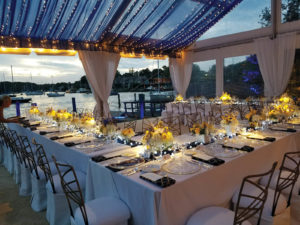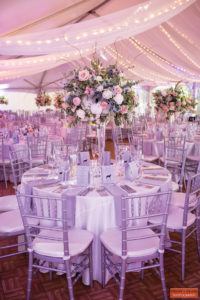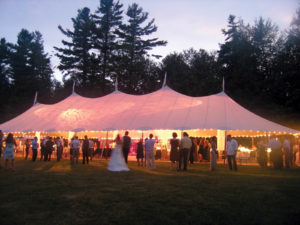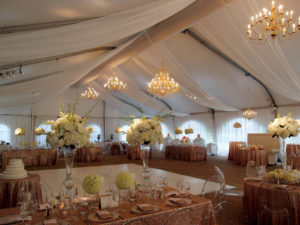
While LED technology changes the industry, social media drives trends in lighting for tented events.
Back in the dark ages—before the internet and the rise of social media—decorative lighting was rarely a major consideration for tented events.
“When I got married, there was no lighting,” says Sandy Mulrey, director of sales and marketing at DesignLight, a Dover, Mass.-based design lighting company. “We didn’t know anything about that.”
“Lighting was usually done because you had to have light, not because you wanted to be decorative,” adds Sharon Mertens, owner of Tentwares Accessory Catalog, Manchester, N.H. “It was often just a couple of floodlights or some plastic lighting, just some lightbulbs really. But that’s all changed. Now even small parties want to be decorative.”
As with every other tent and event trend, social media has changed the way creative ideas spread and raised the aspirations of clients hosting all sorts of parties.
“Our clients are much more aware of the impact lighting can have,” Mulrey says. “With weddings, for example, brides who don’t know what they want to do can go on Pinterest and find beautiful examples of what’s been done.”
“There are so many photographs out there of the cool things you can do,” explains Mertens. “The more information you have, the more you can do.”

On-trend and untrendy
One of the most commonly photographed and shared event lighting trends is café and bistro-style string lighting, Mertens says. This style of lighting is versatile enough to work in a variety of tent settings, from rustic to formal.
Also, a resurgence in the use of chandeliers proves that “what’s old can be new again,” Mulrey says. The style varies—for example, wrought iron with candle-style lights works in rustic settings, while black-tie events need the upscale look of crystal. The use of florals added to the chandelier is also popular, she says.
So too is the use of chandeliers outside of the tent. “We recently did an event with a sphere chandelier hanging from the limb of a tree next to the pathway to the tent, with the seating chart arrangement hanging right next to it,” Mulrey says. “It was really pretty.”
As anyone responsible for selecting event rental inventory knows, one of the downsides of social networking sites and influencer marketing is their contribution to the rapid pace at which trends change.
“For a while, everybody wanted paper lanterns,” says Mertens. “[Tentwares] started with white to see what might happen and it just exploded—I think we had 40 colors, in every size. Then, just as fast as it came in, it went out.”
To counter that, Mertens says, lighting companies and event producers need to be a little “untrendy.”
“You pay attention to social media and to the magazines, but you keep your options open,” she says. “You don’t want to only carry rustic barn looks, no matter how popular that might be.”

LED advancements
While social media drives event design trends, evolving technology may be responsible for an even higher degree of change in event lighting. Specifically, LED lighting is transforming the industry.
“We started using LEDs in the past year,” says Bryan Loane, a sixth-generation owner of Loane Bros. Inc., a party tent rental company in Towson, Md. “We stuck with incandescents because the lighting is so nice looking. The original LEDs weren’t very flattering and there was no dimming. You need to be able to adjust lighting, even as an event is going on. But the LEDs now are much more natural looking, and they can be dimmed.”
Incandescents are still selling, but many Tentwares customers are switching to LEDs, Mertens says. “Over the past couple of years, we have added plastic LED bulbs to every size socket we have, in different configurations and shapes,” she adds.
LEDs cost more than incandescents but are available in shatter-resistant plastic bulbs that are more durable than glass, a key factor for any product that will be installed and then removed over and over.
“Decorative [outdoor] lighting was not meant to be put in a tent; it was meant to be put in your backyard and that was that,” Mertens says. “When tents are put up and taken down, bulbs break. But not [plastic] LEDs.
“If you’re working at a beach location or a parking lot where wind can break the bulbs, a lot of people switch over to LEDs because the fire marshal tells them they have to,” she adds. “And then it turns out to be a good thing because there’s so much more you can do with LEDs.”
LEDs draw only a fraction of the power required by incandescents, another plus given that café and bistro-style lighting often requires a large number of lights to be strung together.
In addition, LEDs can be more easily powered by battery packs in places where electrical outlets are limited or unavailable, which gives the event producers more options. Lighting designers often don’t know where the poles and posts of a tent will be until they are on site, says Chris Romero, owner of Cutmaster Music, an event company in Albuquerque, N.M.
“If you’re stuck having to plug things in, it makes everything a lot tougher,” he says. “For example, we frequently use battery-powered uplights for accent lighting, shine them at different angles throughout the tent, which gives the tent ceiling some pop and some color.”

Light up the night
Even when the interior of a tent is well lit, the surrounding area may be dark, as tents are often installed in locations with little or no permanent lighting. And as important as exterior lighting is for overall event design, it’s even more important for the safety of guests and fellow vendors who are often loading out at night, Loane says.
“With battery power, we can use uplights to highlight trees and bushes in places you can’t run a cord, which is incredible,” he says. “And if the
lights need to be adjusted or moved around, it’s not a problem.”
Another recent advancement in lighting technology is a hybrid of LEDs with traditional bulbs, which offers a versatile combination, Romero says.
“Before, we used lights that only had gobos in them, and you couldn’t get a nice wash, or you used LED lights that were specifically for wash lighting,” Romero explains. “With hybrid technology, you get all of that in one light, which is pretty amazing.”

Amazing—but not cheap. “Hybrid lights run more than $1,000 a piece,” Romero says. “But if you’re doing enough events a year and you’re trying to stay in front of your competition, that’s the cost of doing business and progressing in the event market.”
While trends may change the way events look, lighting and event experts don’t expect the popularity of decorative lighting to wane.
That’s because clients have finally figured out just how impactful lighting can be, Mulrey says. “The best example of that is an event that transitions from day to evening. The right lighting can look just gorgeous when the sun starts to set. People may not necessarily understand what’s happening, but they have that warm, innate sense, ‘this feels good.’”
Jeff Morevac is a freelance writer based in Minneapolis, Minn.
It’s easy to tick off the advantages of LEDs over incandescent bulbs—less power draw, durability, versatility and so on. But when it comes to price, LEDs are simply more expensive than incandescents.
In addition, purchasers of LED lighting are often confronted with a much wider price range than incandescents. So is it wise to price shop?
“With incandescent bulbs, the quality is pretty consistent,” says Sharon Mertens, owner of Tentwares Accessory Catalog, Manchester, N.H. “But with LEDs, not all bulbs are created equal.”
Different LED manufacturers produce bulbs of varying quality, she says, and the cheapest ones—like those sold in big box home stores—are not the same as the more expensive ones.
Why? “What makes LEDs work the way they do are computer chips,” Mertens says. The light actually comes from the chip glowing when electricity passes through it.
“We all know that every computer is not the same—that there’s a difference between the cheap ones and the expensive ones,” she says. “It’s the same with the lights.”
LEDs manufactured with higher quality control standards and components will simply continue to work longer, she says. So while the upfront costs may be higher, they can be less expensive in the long run.
 TEXTILES.ORG
TEXTILES.ORG


